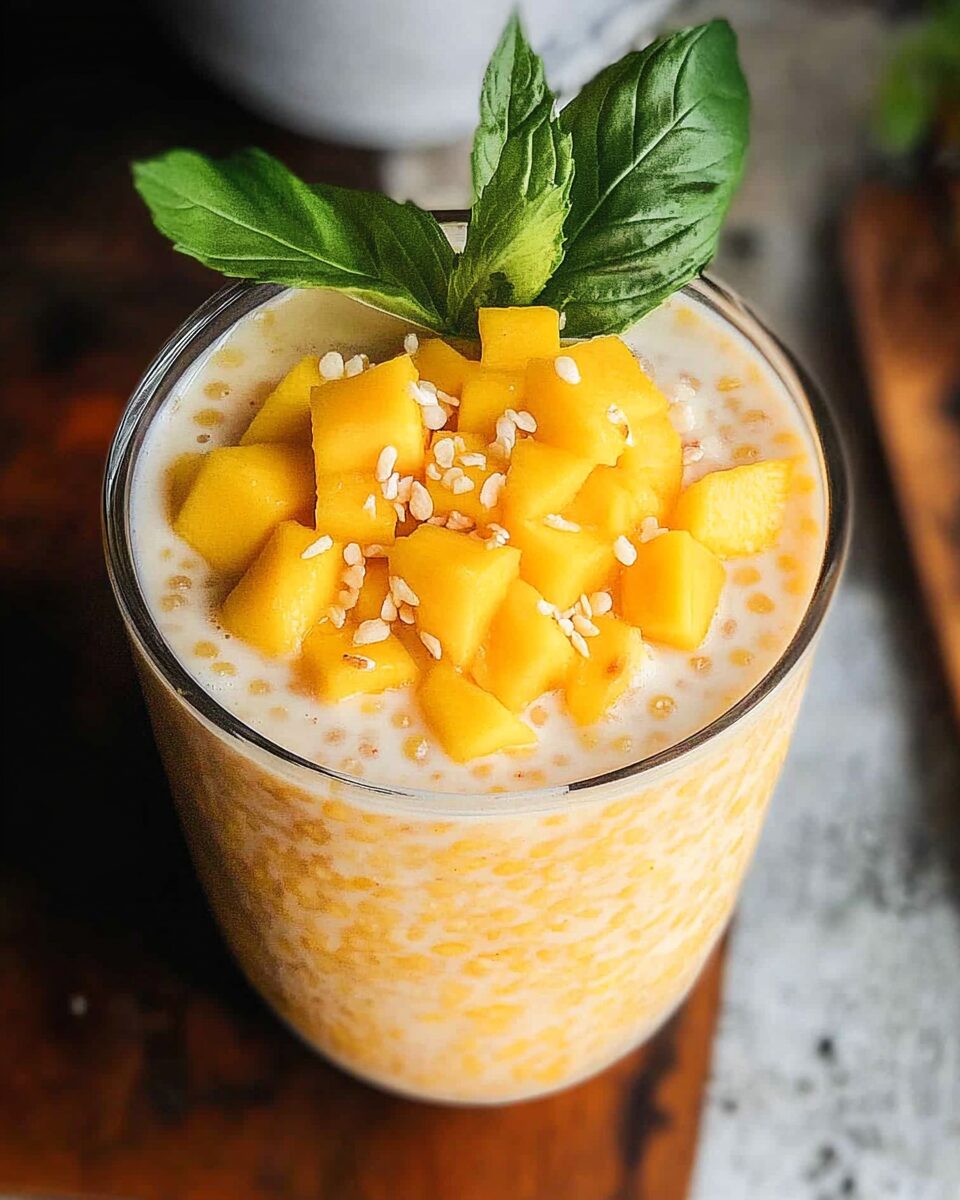Mango Sago combines the vibrant, juicy sweetness of ripe mangoes with the delicate, chewy texture of sago pearls, creating a dessert that’s both refreshing and satisfying. The creamy coconut milk adds a tropical richness to this simple, yet elegant dish.
Perfect for hot summer days, this dessert is not only easy to make, but it’s also a versatile treat that can be enjoyed as a light snack, a crowd-pleaser at parties, or a sweet end to a meal. With its vibrant colors and cooling effect, Mango Sago will surely become your new favorite dessert!
Full Recipe:
- 1 ½ cups mango, peeled and diced
- ½ cup sago pearls
- 1 ½ cups coconut milk
- 1 tablespoon sugar (optional)
- 2 cups water
- Ice cubes for serving
Directions:
- Rinse the sago pearls thoroughly under cold water until the water runs clear.
- In a saucepan, bring 2 cups of water to a boil. Add the sago pearls and cook for 10-12 minutes, stirring occasionally. Once the pearls turn translucent, remove from heat and drain the sago.
- In another saucepan, heat the coconut milk over medium heat. Add sugar if desired, and stir until dissolved.
- Combine the cooked sago pearls with the coconut milk mixture and let cool for a few minutes.
- Add the diced mango and stir gently to combine.
- Chill the mixture in the fridge for at least 30 minutes.
- Serve with ice cubes for a refreshing treat.
Prep Time: 15 minutes | Cooking Time: 15 minutes | Total Time: 45 minutes
Kcal: 160 kcal | Servings: 4 servings
Introduction to Mango Sago
Mango Sago is a sweet, refreshing dessert that has won hearts across the globe, especially in Asian cuisine. It is a popular choice due to its combination of creamy coconut milk, chewy sago pearls, and the rich sweetness of ripe mangoes. This chilled dessert is often enjoyed on hot summer days or at celebratory occasions, as its tropical flavors offer a satisfying treat that’s both light and indulgent.
The texture of Mango Sago is one of its key attractions. The sago pearls, similar to tapioca pearls, provide a chewy contrast to the smooth, velvety coconut milk. The mangoes, when added fresh, contribute a natural sweetness that enhances the overall flavor of the dish, making it a truly irresistible treat.
The Origins of Mango Sago
Mango Sago originates from Southeast Asia and has grown in popularity across the world, particularly in countries like China, Thailand, and the Philippines. It is often enjoyed as a dessert in restaurants, but its easy preparation makes it a great option for home cooks too.
The dish has become a staple in many Asian eateries due to its refreshing nature and simplicity. The balance of textures—chewy sago pearls, creamy coconut milk, and fresh mango—offers a sensory experience that’s hard to beat.
Why Mango Sago is So Popular
There are several reasons why Mango Sago has gained such widespread appeal. One of the main reasons is the ease with which it can be prepared. This dessert doesn’t require complicated techniques, and it only involves a few basic ingredients, making it an accessible recipe for both beginner and experienced cooks.
Another reason is its versatility. While the traditional version calls for coconut milk and mango, this dessert can be easily adapted to suit different preferences. For example, you could substitute the coconut milk for almond or oat milk for those who have dairy sensitivities. You can also experiment with different fruits to create variations, such as using lychees or strawberries.
The dessert’s ability to be served chilled is also an advantage, especially on hot days when you need a cool, refreshing snack or dessert to enjoy.
The Health Benefits of Mango Sago
Mango Sago isn’t just delicious, it also comes with some health benefits. Mangoes are loaded with vitamins, particularly vitamin C, which supports immune function and promotes skin health. They also contain fiber, which aids in digestion and keeps you feeling fuller for longer.
Sago pearls, though not particularly high in nutrients, are a good source of carbohydrates, which provide energy. They also have a neutral flavor, making them an excellent base to soak up the coconut milk and enhance the overall dessert experience.
When made with coconut milk, Mango Sago becomes a source of healthy fats. Coconut milk is rich in medium-chain triglycerides (MCTs), which are known to support brain function and provide quick energy. This combination of mango, sago, and coconut milk results in a dessert that not only tastes great but also offers some nutritional value.
How to Customize Your Mango Sago
While the traditional Mango Sago recipe is simple and classic, there are many ways to customize this dessert to suit your tastes.
One of the easiest ways to change it up is by adjusting the sweetness. Depending on your preferences, you can add more or less sugar to the coconut milk mixture. If you prefer a more natural sweetener, you could use honey or maple syrup as an alternative.
For a more textured dish, you can add some additional fruits like strawberries, kiwi, or lychee. These fruits pair well with mango and add a colorful element to your dessert.
You can also try adding a splash of lime juice to the mixture to bring a zesty twist to the dish. The acidity of lime will contrast nicely with the sweetness of the mango and coconut milk, creating a refreshing balance.
Serving Mango Sago
Mango Sago is best served chilled, making it the perfect summer dessert or a treat to enjoy after a hearty meal. The creamy, cold texture is refreshing and soothing. For an added visual appeal, you can garnish the dessert with extra mango pieces, mint leaves, or a drizzle of coconut milk on top.
It is also commonly served in small cups or bowls, making it an ideal dessert for gatherings and parties. Its bright yellow color and tropical vibes make it an excellent choice for events, especially those with a summery or tropical theme.
Mango Sago as a Versatile Dessert
The beauty of Mango Sago lies in its versatility. You can enjoy it as a dessert on its own, but it can also be paired with other dishes. For example, it goes wonderfully with savory foods like grilled meats or seafood. The balance of sweet and savory makes it a perfect side or accompaniment to more substantial meals.
It also works well with other Asian-inspired desserts, such as bubble tea, matcha-flavored treats, or pandan cakes. Pairing Mango Sago with another tropical drink or snack can elevate your culinary experience.
Conclusion: Why You Should Try Mango Sago
Mango Sago is a dessert that perfectly blends simplicity with flavor. It’s easy to make, requires minimal ingredients, and is an ideal treat to cool off on hot days. The combination of creamy coconut milk, chewy sago pearls, and fresh mangoes offers a tropical delight that’s both satisfying and refreshing.
Whether you’re looking for a quick dessert to make at home or planning a tropical-themed party, Mango Sago is a versatile dish that can be adapted to suit various tastes and occasions. So, the next time you crave a sweet, refreshing treat, consider giving Mango Sago a try. You won’t be disappointed with its creamy texture and bright, tropical flavors!






